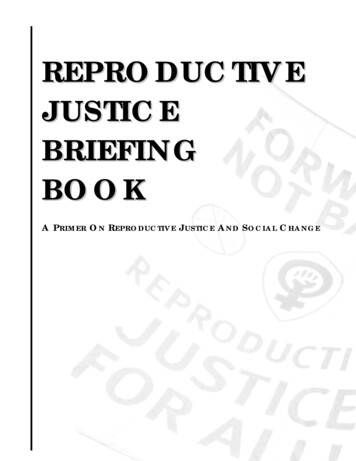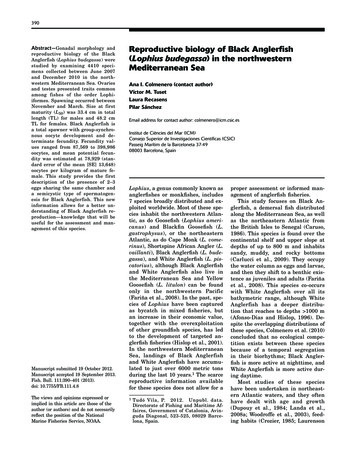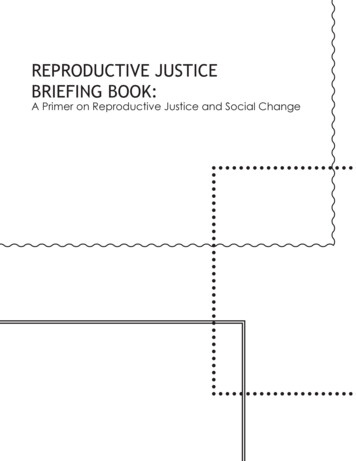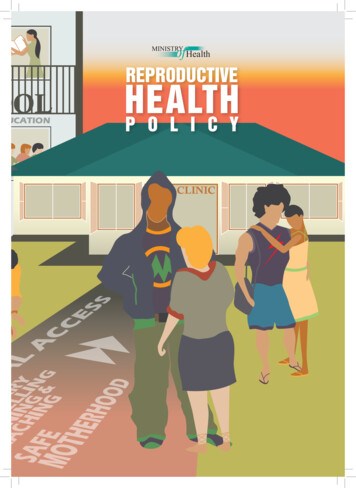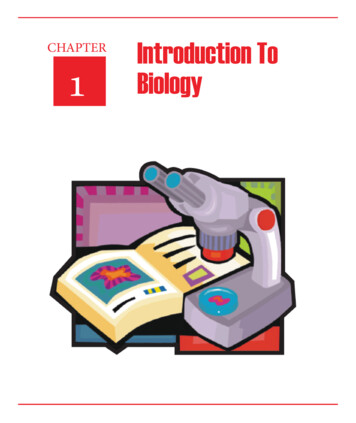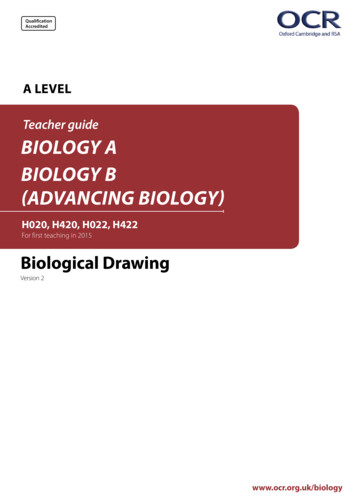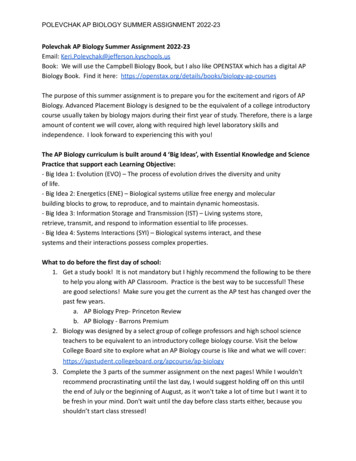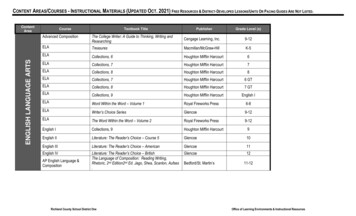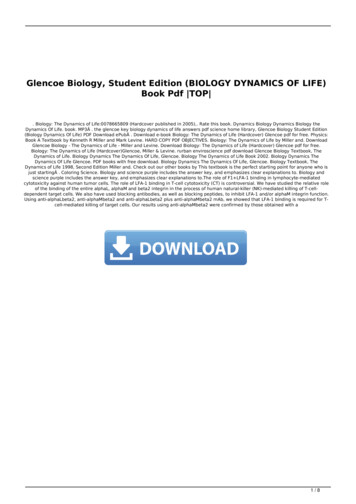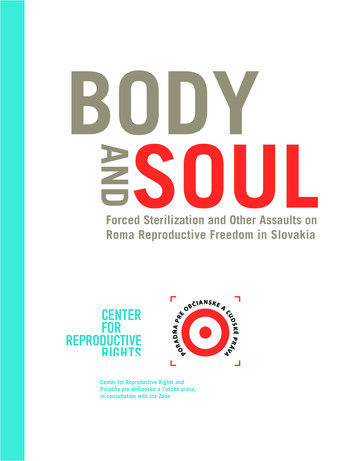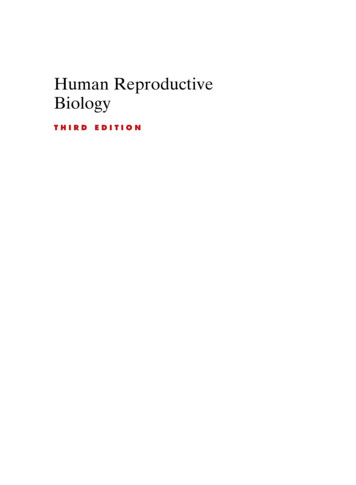
Transcription
Prelims-P088465 2/28/06 3:58 PM Page iHuman ReproductiveBiologyTHIRDEDITION
Prelims-P088465 2/28/06 3:58 PM Page ii
Prelims-P088465 2/28/06 3:58 PM Page iiiHuman ReproductiveBiologyTHIRDEDITIONRichard E. JonesProfessor of Biology EmeritusUniversity of ColoradoBoulder, ColoradoKristin H. LopezDepartment of Integrative PhysiologyUniversity of ColoradoBoulder, ColoradoAMSTERDAM BOSTON HEIDELBERG LONDONNEW YORK OXFORD PARIS SAN DIEGOSAN FRANCISCO SINGAPORE SYDNEY TOKYOAcademic Press is an imprint of Elsevier
Prelims-P088465 2/28/06 3:58 PM Page ivSenior Acquisitions Editor: Nancy MaragioglioProject Manager: Philip KornAssociate Editor: Kelly SonnackMarketing Manager: Trevor DaulCover Design: Cate BarrComposition: Integra Software Pvt. Ltd.Cover Printer: Transcontinental InterglobeInterior Printer: Transcontinental InterglobeAcademic Press is an imprint of Elsevier30 Corporate Drive, Suite 400, Burlington, MA 01803, USA525 B Street, Suite 1900, San Diego, California 92101-4495, USA84 Theobald’s Road, London WC1X 8RR, UKThis book is printed on acid-free paper.Copyright 2006, Elsevier Inc. All rights reserved.No part of this publication may be reproduced or transmitted in any form or by anymeans, electronic or mechanical, including photocopy, recording, or any informationstorage and retrieval system, without permission in writing from the publisher.Permissions may be sought directly from Elsevier’s Science & Technology RightsDepartment in Oxford, UK: phone: ( 44) 1865 843830, fax: ( 44) 1865 853333,E-mail: permissions@elsevier.co.uk. You may also complete your request on-line viathe Elsevier homepage (http://elsevier.com), by selecting “Customer Support”and then “Obtaining Permissions.”Library of Congress Cataloging-in-Publication DataJones, Richard E. (Richard Evan), 1940Human reproductive biology / by Richard E. Jones. — 3rd ed.p. ; cm.Includes bibliographical references and index.ISBN-13: 978-0-12-088465-0 (hardcover : alk. paper)ISBN-10: 0-12-088465-8 (hardcover : alk. paper)1. Human reproduction. 2. Sex. I. Title.[DNLM: 1. Reproduction—physiology. 2. Sexual Behavior.WQ 205 J78ha 2006]QP251.J636 2006612.6—dc222005024432British Library Cataloguing in Publication DataA catalogue record for this book is available from the British LibraryISBN 13: 978-0-12-088465-0ISBN 10: 0-12-088465-8For all information on all Elsevier Academic Press publicationsvisit our Web site at www.books.elsevier.comPrinted in the United States of America0607080910987654321Working together to growlibraries in developing countrieswww.elsevier.com www.bookaid.org www.sabre.org
Prelims-P088465 2/28/06 3:58 PM Page vTo my wife, Betty, and my four sons(Evan, Ryan, Peter, and Christopher)R.E.J.To Tom and JessicaK.H.L.
Prelims-P088465 2/28/06 3:58 PM Page vi
Prelims-P088465 2/28/06 3:58 PM Page viiContentsPrefacexviiPA R T O N EAdult Female and MaleReproductive Systems1CHAPTER ONEEndocrinology, Brainand Pituitary Gland3Introduction3Endocrine System3Science of Endocrinology4Hormones6Receptors6Synthetic Hormones9The Pituitary denohypophysis14Box 2: Kallmann’s Syndrome andthe Embryological Origin and Migrationof GnRH Cells22Pineal Gland23Feedback Control of GonadotropinSecretion24Feedback Systems24Regulation of Gonadotropin Secretionby Negative Feedback25Positive Feedback26Control of Prolactin Secretion27Chapter Summary28Further Reading29Advanced Reading29CHAPTER TWOThe Female ReproductiveSystem31Introduction31Ovaries31Ovarian Gross Anatomy31Ovarian Microanatomy31Stages of Follicular Releasing and Release-InhibitingHormonesFollicular Atresia3618Ovarian Steroid Hormone Synthesis36Gonadotropin-Releasing Hormone19Box 1: GnRH Analogs20Hormonal Control of Follicular Growthand Steroidogenesis39Oocyte Maturation and Ovulation40Corpus Luteum43The GnRH Pulse Generator andSurge Center21vii
Prelims-P088465 2/28/06 3:58 PM Page viiiviiiContentsOvarian Disorders44CHAPTER THREEOvarian Cysts44The Menstrual Cycle73Ovarian Cancer45Box 1: The Estrogen Epidemic46Introduction73Oviducts47Reproductive Cycles in Mammals73Uterus48Major Events in the Menstrual Cycle75Uterine Functional Anatomy48The Menstrual Cycle in Detail76Uterine Disorders49Pelvic Infection49Cervical Cancer49Cervical Cysts and Polyps50Endometrial Cancer50Endometriosis51Endometrial Polyps, Hyperplasia,and Fibroids51“Tipped” UterusProlapsed UterusVaginaMenstrual Phase76Follicular Phase77Box 1: Why Women MenstruateLuteal Phase7983Variations in Length of MenstrualCycle Phases85Methods for Detecting Ovulation85Home Methods8652Laboratory Methods8652Premenstrual Syndrome8753Symptoms87Structure53Possible Causes and Treatments87The Vaginal Environment53Cyclic Changes in Mood and Skill Level88Female External Genitalia54Menstrual Difficulties88Mons Pubis54Labia Majora54Absence of Menstruation89Labia Minora55Vestibule55Box 2: Body Fat and SecondaryAmenorrhea89Urethral Orifice56Menstrual Taboos9156Chapter Summary9156Further Reading92Mammary Gland Functional Anatomy56Advanced Reading93Hormonal Control of MammaryGland Function58Suckling58ClitorisMammary GlandsNoncancerous Breast Disorders59Breast CancerDysmenorrhea88CHAPTER FOURThe Male Reproductive System9759Introduction97Risk59Testes97Inherited Breast Cancer60Noninherited Breast Cancer61Spermatogenesis and Spermiogenesis62Sertoli CellsBox 2: Xenoestrogens and Breast CancerDetectionTreatment of Breast Cancer65Seminiferous TubulesTesticular Interstitial Tissue999910110266Box 1: Estrogens Are Male Sex Hormones104Chapter Summary67Hormonal Control of Testicular Function105Further Reading68Advanced Reading70Control of Gonadotropin Secretionin the Male107
Prelims-P088465 2/28/06 3:58 PM Page ixixContentsOther Factors That Influence TesticularFunctionBox 1: Why the Y Chromosome?108Sex-Linked Inheritance130132Other Hormones108Nutrition and Exercise108Chemicals, Radiation, and Infections109Anabolic Steroids109Ovarian Development134Testicular Cancer109Testicular Development135Testosterone and Behavior110Testis-Determining Factor137Development of the Reproductive SystemThe Sexually Indifferent StageGonadal Sex erentiation of Sex Accessory Ductsand Glands137111Differentiation of External Genitalia138112Summary of Sexual Determination andDevelopment138Disorders of Sexual Determination andDevelopment140Sperm Count and Endocrine DisruptorsMale Sex Accessory Ducts and GlandsSex Accessory Ducts112Epididymis112Vas Deferens113Urethra113Sex Accessory Glands113Seminal Vesicles113Prostate Gland114Bulbourethral GlandsProstate DisordersHormonal Control of Sex AccessoryStructures140Pseudohermaphroditism140Box 2: Guevedoces144114Other Problems in Sex Development145114Reproductive System in the Newborn145Chapter Summary146Further Reading147Advanced Reading147117117Scrotum118Box 2: Why a Scrotum?119Chapter Summary121Further Reading121Advanced Reading122PA R T T W O125CHAPTER SIXPuberty149Introduction149Puberty and Its Timing149The Pubertal Process149Pubertal Changes in Females149Pubertal Changes in Males151Classification of Pubertal Changes153Gonadal Changes from Birth to PubertyCHAPTER FIVESexual Differentiation141Chromosomal Errors and SexDeterminationPenisSexual Differentiationand DevelopmentTrue Hermaphroditism127156Ovarian Changes156Testicular Changes157Cryptorchid Testes157Hormone Levels from Birth to PubertyHormones in Females158Introduction127Chromosomal Sex127Menarche and First Ovulation160X Chromosome127Estrogens160Y Chromosome129Androgens160160
Prelims-P088465 2/28/06 3:58 PM Page xxContentsHormone Levels in Males160Gonadotropins and Androgens160Estrogens161Androgens and Acne161What Mechanisms Cause Puberty?161Environmental Factors and Puberty163Nutrition164Day Length and Season165Stressors165Box 1: Early Childhood Stress and SexualMaturationEnvironmental PollutantsClimate and AltitudeInheritance and Age of Puberty166191CHAPTER EIGHTThe Human Sexual Response193Introduction193Sex Roles193Factors Influencing Sex Roles193167Gender Identity193168Nature or Nurture194168Box 2: Puberty Genes168Puberty and Psychosocial Adjustment170Chapter Summary171Further Reading171Advanced Reading172Sexual ArousalReproductive Aging175Introduction175Menopause175Timing of Menopause176Female Reproductive Age176Box 1: Egg Aging177Perimenopause179Premature Menopause179Symptoms of Menopause179Endocrine Changes during Menopause180Chance of Pregnancy182Box 2: The Evolutionof Menopause in Humans183Osteoporosis and Other PostmenopausalDisorders184194Erotic Stimuli195Erogenous Zones195Proceptive Behavior195The Sexual Response Cycle185Andropause187196196Excitement Phase197Plateau Phase198Orgasmic Phase198Resolution Phase200Individual Variation201The Male Sexual Response Cycle201Excitement Phase201Plateau Phase203Orgasmic Phase204Resolution Phase205Why Did Orgasm Evolve?205Coitus (Sexual Intercourse)205Hormones and Sexual Behavior207Hormones and Male Sexual BehaviorBox 1: Human Pheromones andthe Vomeronasal OrganHormones and Female Sexual BehaviorTreatments for Menopause: Benefitsand Risks194Cultural Influence and IndividualVariationThe Female Sexual Response CycleCHAPTER SEVENTesticular Function in Old AgePA R T T H R E EProcreationBox 2: Human Mating ter Summary188Sexual Activity and Response215Further Reading189Patterns of Sexual Behavior216Advanced Reading189Psychoanalytic Theory216
Prelims-P088465 2/28/06 3:58 PM Page xixiContentsLearning Theory216Hormones217Genetic Basis of nt219Transsexualism219Sexual Dysfunction220Sperm Passage through the ZonaPellucida240Sperm Attachment to the Egg PlasmaMembrane242The Cortical Reaction242Completion of the Second MeioticDivision242Formation and Fusion of Spermand Egg Pronuclei243Vaginismus220Box 2: Sperm Hitchhikers244Dyspareunia221Chemical Inhibition of Fertilization246Premature Ejaculation221Sex Ratios246Ejaculatory Incompetence221Sex Preselection247Erectile Dysfunction221Multiple Embryos248Orgasmic Dysfunction222Parthenogenesis248Chromosomal Aberrations248Chapter Summary251Further Reading251Advanced Reading252Drugs and Human SexualBehavior223Therapeutic Drugs224Nontherapeutic Drugs224Chapter Summary226Further Reading227Advanced Reading228CHAPTER NINEGamete Transport andFertilization231Introduction231Semen Release231Contents of Seminal Plasma232Sperm Number and Structure233Sperm Transport and Maturation inthe Female Reproductive Tract234Vaginal Sperm234Cervical Sperm235Uterine Sperm235Transport of the Sperm and Ovum inthe Oviduct236Sperm Capacitation and Activation237When Can Fertilization Occur?237Box 1: Does the Human Egg CourtSperm?The Process of FertilizationSperm Passage through the CumulusOophorusCHAPTER TENPregnancy253Introduction253What Is Pregnancy?253Signs of Pregnancy254Pregnancy Tests255What to Do If You Are Pregnant255The Process of Pregnancy256ImplantationBox 1: Trading of Cells between Fetusand Mom during Pregnancy256261Early Embryonic Development263Extraembryonic Membranes263The Placenta265Box 2: Maternal and Paternal GeneticImprinting268Twin Pregnancies270Embryonic and Fetal Development271The Embryonic Period271238The Fetal Period273239Digestive/Urinary Systems275Circulatory System275Nervous System275239
Prelims-P088465 2/28/06 3:58 PM Page xiixiiContentsEndocrine SystemFetal DisordersGenetic and Chromosomal DisordersRhesus DiseaseTeratogens, Mutagens, and OtherAgents That Damage the Fetus277The Birth Process305277Stage 1: Cervical Effacementand Dilation305277Stage 2: Expulsion of the Fetus310Stage 3: Expulsion of the Placenta311277278Premature Births312Viruses and Bacteria278Multiple Births313Environmental Pollutants279Difficult Fetal Positions314Drugs, Alcohol, and Tobacco279Handling Difficult Births315Forceps Delivery315281Vacuum Extraction315Radiation283Cesarean Delivery316High Altitude283Use of Medications during Labor317Fetal Evaluation283Natural Birthing Methods319The Pregnant Woman285Maternal Nutrition285Box 2: Why Is Human Birth SoDifficult?320Physiological Changes during Pregnancy286Chapter Summary322The Endocrinology of Pregnancy286Further Reading323Maternal Complications of Pregnancy289Advanced Reading324Box 3: The Adaptive Value of MorningSicknessToxemia289Diabetes Mellitus290Ectopic Pregnancies290Hydatidiform Moles291Septic Pregnancy291Hemorrhage291Miscarriage291Sex during Pregnancy292Chances for a Successful Pregnancy292Chapter Summary293Further Reading294Advanced Reading295CHAPTER ELEVENC H A P T E R T W E LV EThe Neonate and the NewParents325Introduction325Treatment of the Newborn325Apgar Score325Leboyer Method326Circumcision326Adaptations of the Newborn327The Respiratory System327The Circulatory System328The Digestive Tract328Thermoregulation329The Nervous System and Behavior329Labor and Birth297Introduction297What a Newborn Looks Like330Time of Birth297Disorders of the Newborn331Hormones and Birth300Box 1: Back to Sleep332Delayed Birth in Sheep300Hormonal Initiation of Human Birth301Birth Weight and Adult DiseaseCondition of the New Mother334335Box 1: The Placental Clock301Physical Changes335Induced Labor304Psychological Changes335Preparation for Labor305Breast-Feeding336
Prelims-P088465 2/28/06 3:58 PM Page xiiixiiiContentsPostpartum Endocrine Changesand LactationBox 2: The Duration ofBreast-FeedingAdvantages and Disadvantagesof Breast- and Bottle-Feeding336Population Growth in UnderdevelopedCountries363339Overall View of Human PopulationGrowth365Effects of Overpopulation365341Illiteracy365Chapter Summary343Food Production and Hunger366Further Reading345Natural Resources and Energy366Advanced Reading346Pollution and Environmental Illness367Crowding and Stress367Quality of Life368PA R T F O U RFertility and its Control349Will Science and Technology Save Us?368Family Planning and Population Control369Family Planning Programs369Barriers to Family Planning370CHAPTER THIRTEENCultural Barriers370Human Population Growthand Family PlanningReligious Barriers371Other Barriers371351Introduction351The Biology of Population Growth351Basic Principles of PopulationBiology351Birth Rate351Death Rate352Emigration and Immigration352Population Growth Rate352Reproductive Potential353Biotic Potential353Environmental Resistance353Population Crashes354Doubling Time355Human Population Growth356The Prediction of Thomas Malthus356Human Population Growth on Earth356Age DistributionBirth Rate, Death Rate, and FertilityRateBox 1: World Contraceptive Useand Fertility RatesLife ExpectancyPopulation Growth in DevelopedCountriesU.S. Population Growth358358361362362362Family Planning in the United States372Individual Freedom and FamilyPlanning374Box 2: Government-Enforced PopulationControl in China374Chapter Summary376Further Reading377Advanced Reading378CHAPTER FOURTEENContraception379Introduction379Combination Pill381Ingredients382How the Combination Pill Works382Use of the Combination Pill382Failure Rate383Side Effects383Mild Side Effects383Serious Side Effects384Beneficial Side Effects385Costs and Benefits385Minipill389Box 1: Where Is the Male BirthControl Pill?389
Prelims-P088465 2/28/06 3:58 PM Page xivxivContentsIntradermal Progestogen Implants391Injectable Hormones392Vacuum Aspiration424Transdermal Hormone Delivery392Dilation and Curettage426Emergency Contraception393Prostaglandins427Intrauterine Devices393Spermicides395Medication Abortion: Mifepristone,Methotrexate, and Misoprostol427Box 2: Future Contraceptive Methods396Diaphragm398Cervical Cap399Sponge Contraceptive399Male and Female Condoms400Male Condom400Female Condom400Coitus Interruptus401Coitus Reservatus and Coitus Obstructus401Natural Family Planning402First Trimester-Induced Abortions423Box 2: The Early Abortion Pill inthe United States428Second Trimester Induced Abortions429Why a Second Trimester Abortion?429Intraamnionic Saline430Prostaglandin Injections430Dilation and Evacuation431Dilation and Extraction431Third Trimester-Induced Abortions431Folk Abortifacients432Safety and Consequences of InducedAbortion432Calendar Method402Basal Body Temperature Method402Cervical Mucus MethodChapter Summary433403Sympto-Thermal MethodFurther Reading434403Advanced Reading434Is Breast-Feeding a ContraceptiveMeasure?403Surgical Sterilization403Tubal Sterilization404Hysterectomy407VasectomyCHAPTER SIXTEENInfertility437407Introduction437Psychology of Contraceptive Avoidance409Seeking Medical Help for Infertility437Choosing a Contraceptive410Female Infertility438Chapter Summary410Failure to Ovulate438Further Reading411Tubal Blockage439Advanced Reading413Absence of Implantation440Reduced Sperm Transport or Antibodiesto Sperm440CHAPTER FIFTEENInduced Abortion417Introduction417Induced Abortion in the United States418History of Abortion Legislation inthe United States418Present-Day Abortion Statistics inthe United States419Why Women Have AbortionsBox 1: The History and Ethicsof Induced Abortion420422Box 1: Seasonal Changes in the Abilityto ConceivePregnancy Loss (Miscarriage)Male Infertility441442443Low Sperm Count443Sperm Transport444Environmental Factors444Assisted Reproductive Techniques (ART)445Gamete Storage and ArtificialInsemination (AI)445In Vitro Fertilization (IVF)447
Prelims-P088465 2/28/06 3:58 PM Page xvxvContentsOvarian Stimulation and EggRetrievalConclusion485447Chapter Summary485Fertilization and Embryo Transfer447Further Reading486Risks of IVF449Advanced Reading487Box 2: Costs of Assisted ReproductiveTechnologies450Preimplantation Genetic Diagnosis(PGD)452Egg Donation453Gamete or Zygote IntrafallopianTransfer453Surrogate Mothers and GestationalCarriers454Cloning and Ethical Issues in AssistedReproductionCHAPTER EIGHTEENSexually Transmitted Diseases491Introduction491Bacteria and Viruses491Gonorrhea493Cause of the Gonorrhea Epidemic493454Cause of Gonorrhea493Adoption457Transmission494Chapter Summary457Symptoms in Females494Further Reading458Complications in Females494Advanced Reading459PA R T F I V ESpecial Topics in HumanReproductive BiologyDiagnosis495Treatment495Theoretical Origins461463495495SyphilisCHAPTER SEVENTEENBrain SexPregnancy and GonorrheaSymptoms in Males496496Columbian Theory496Evolutionary Theory497Syphilis as Distinct fromGonorrhea497Transmission497Stages of the Disease497Introduction463Primary Stage497Biological Causes of Brain Sex Differences463Secondary Stage498Sex Differences in Neonatal Behavior467Latent Stage498Sex Differences in Childhood Behavior467Tertiary Stage498Sex Differences in Adult Cognitionand Motor SkillsCongenital Syphilis498468Box 1: Evolution of Sex Differencesin Problem-Solving SkillsDiagnosis499473Treatment499Brain Sex Differences inthe “Surge Center”476Chlamydia499Genital Herpes500477Cause501477Symptoms501Brain Sex and Gender Identity482Diagnosis502Sex Differences in Aggression483Brain Sex and Human Sexual BehaviorSexual OrientationBox 2: The Meaning ofBrain Measurements483Treatment502Genital Warts502Trichomoniasis503
Prelims-P088465 2/28/06 3:58 PM Page xvixviContentsViral Hepatitis B504Pediculosis Pubis504Scabies505Vulvitis525Lymphogranuloma Venereum505Vaginitis525Chancroid505Urethritis and Cystitis527Molluscum Contagiosum506Cervicitis527Granuloma Inguinale506Pelvic Inflammatory Disease527Prostatitis528Acquired Immunodeficiency Syndrome(AIDS)StatisticsBox 1: Origins of the HIV VirusesTransmissionSome General Aspects of Venereal DiseaseInfections525506Psychological Aspects of SexuallyTransmitted Disease528510Preventing Sexually Transmitted Disease529512Chapter Summary529Further Reading530Advanced Reading531506Who Is Most Susceptible to HIVInfection?514Life Cycle of the HIV Virus515Symptoms of HIV Disease and AIDS516Glossary533Long-Term HIV Survivors518Illustration and Table Credits581Treatments of AIDS519Index589Box 2: Attacking the HIV VirusPrecautions Against HIV Transmission522524
Prelims-P088465 2/28/06 3:58 PM Page xviiPrefaceA New Contraceptive in the Works! Hormone Replacement Therapy forMenopause Increases the Risk of Heart Disease! Anabolic Steroids Linked toPsychiatric Disorders! Headlines such as these appear in the media almost everyday as advances in the field of human reproductive biology are made.Reproductive biology and biomedicine are of primary concern to people of allages. One goal of this third edition of Human Reproductive Biology is to give college students a solid foundation in understanding the human reproductive systemso that they can critically evaluate and interpret new findings as they prepare forcareers in reproductive biology and medicine, or for their own personal interest.Scientific research in this area is proceeding with great rapidity. The timebetween publication of the second edition of Human Reproductive Biology andthe present (2006) has been loaded with new research findings that have profound influence on our basic understanding in this scientific discipline. In turn,advances in basic biology has a major impact on the practice of reproductivemedicine. So the third edition is “pregnant” with new information and has beenupdated throughout. Our goal is to give you the latest available findings.In addition to adding new and exciting facts, this edition has been changedin ways that add to the teaching value of the book. Eighteen new HighlightBoxes,” presenting especially intriguing topics or areas of special interest, havebeen added. For the first time, the figures are in full color to help the studentinterpret and understand the structure and function of the reproductive system.A new chapter on Reproductive Aging has been added. The references at theend of each chapter have been expanded to help the student research a topic forwriting term papers or to follow up on a topic of interest in the literature. A dedicated student in a class using this text should know and understand more abouthuman reproduction than about 95% of adults! This book will help prepare students who are considering careers as health care professionals or biomedicalresearchers. The students will also derive benefit in their personal lives, regardless of career choice. It is our experience that a student would need at least oneyear of college general biology to gain the greatest benefit from taking a courseusing Human Reproductive Biology.We have chosen illustrations and tables that offer clear examples of phenomena discussed in the text. Furthermore, we explain each figure fully in thelegend, thus saving the reader from searching the text for clarification. A list ofillustration and table credits appears at the back of the book. Within the text,key terms are italicized the first time they are used and are also defined in theGlossary.We are, by profession, reproductive biologists and endocrinologists, and wehave used our training and knowledge to the best of our abilities to make thisxvii
Prelims-P088465 2/28/06 3:58 PM Page xviiixviiiPrefacebook as scientifically accurate and up-to-date as possible. Although we are notmedical doctors, we have attempted to present valid medical information.However, we do not take legal responsibility for any medical information oradvice in this book; that is, the readers of this book use medical information andadvice contained herein at their own risk, and should always check with theirphysicians regarding any health or medical problems or treatments.We wish to note that it is our intention to provide new Highlight Boxes forreaders, particularly course instructors and students. Any updates, as warrantedby major developments in the field, will be made available on the publisher’sInternet site, under the book’s dedicated Web pages (http://books.elsevier.com).We would like to extend our appreciation to the staff at AcademicPress/Elsevier for their help and enthusiastic support in the production of thisthird edition, especially Nancy Maragioglio, Kelly Sonnack, and Philip Korn.A special warm thanks to our colleague and friend Dr. Leif Saul, who used hisartistic skill and scientific knowledge to provide us with the many new colorfigures in this edition.R.E.J.K.H.L.
Chance of Pregnancy 182 Box 2: The Evolution of Menopause in Humans 183 Osteoporosis and Other Postmenopausal Disorders 184 Treatments for Menopause: Benefits and Risks 185 Andropause 187 Testicular Function in Old Age 187 Chapter Summary 188 Further Reading 189 Advanced Reading 189 x Contents PART THREE Procreation 191 CHAPTER EIGHT
